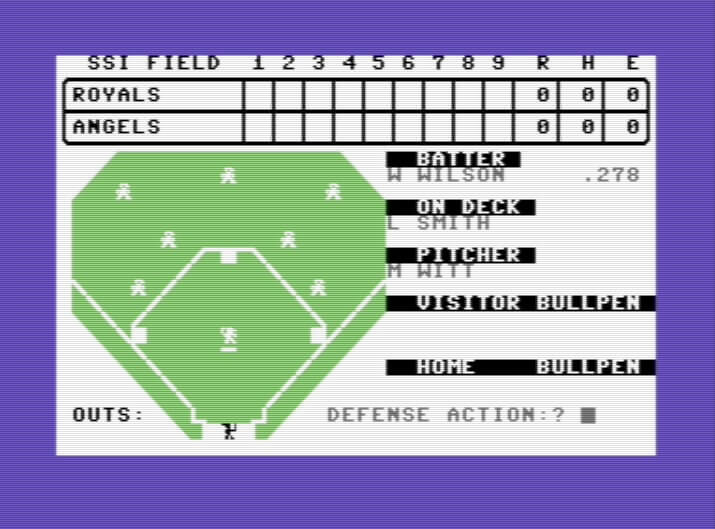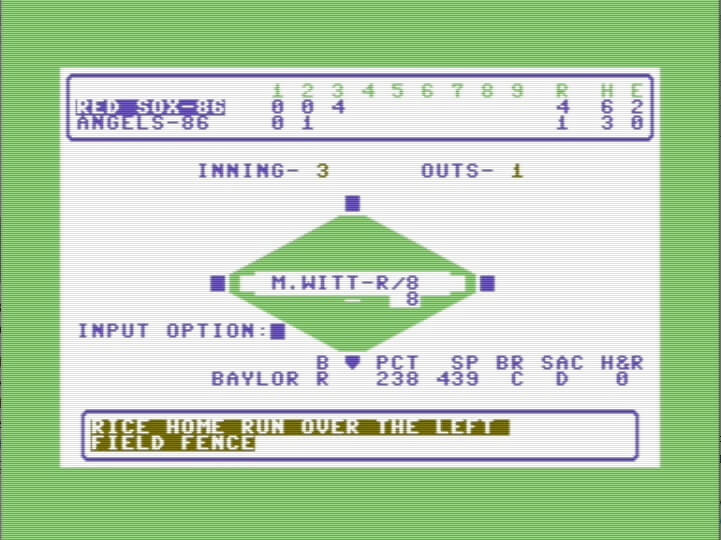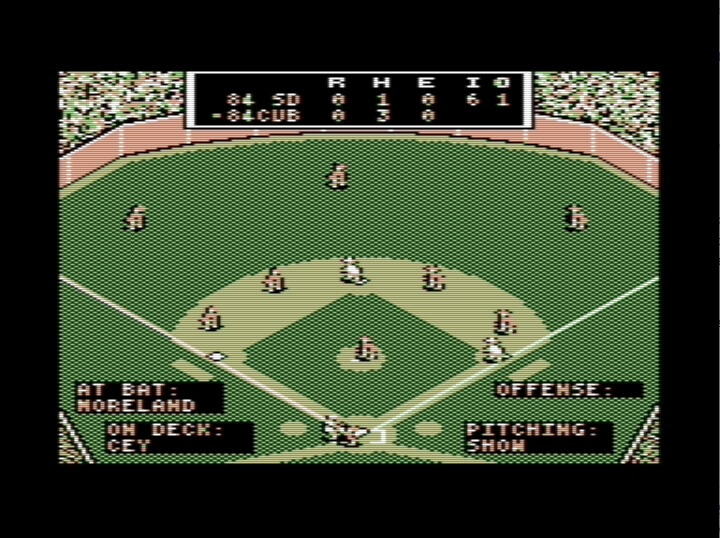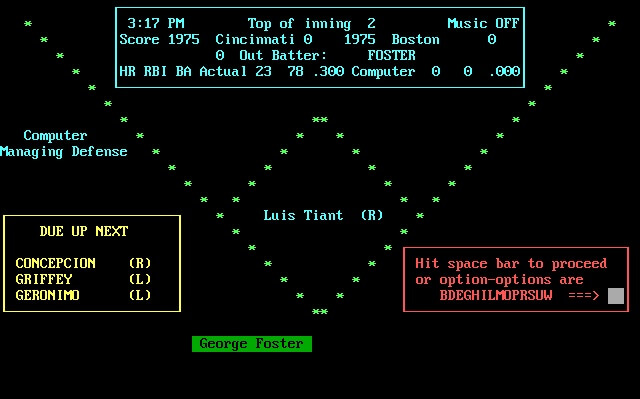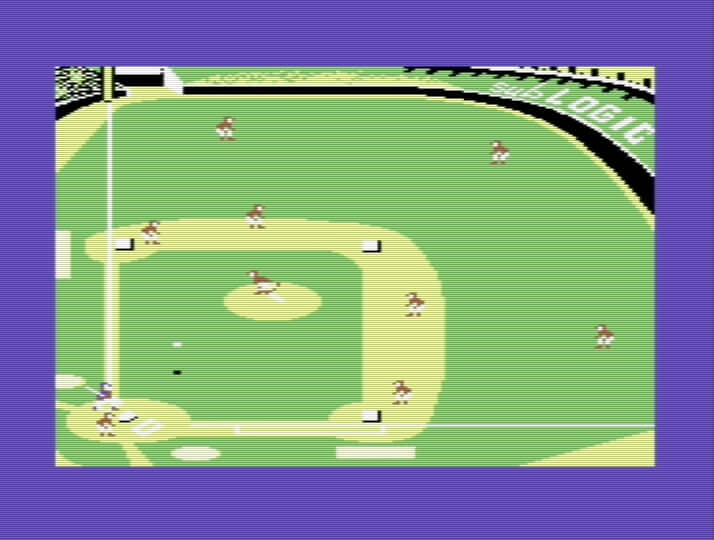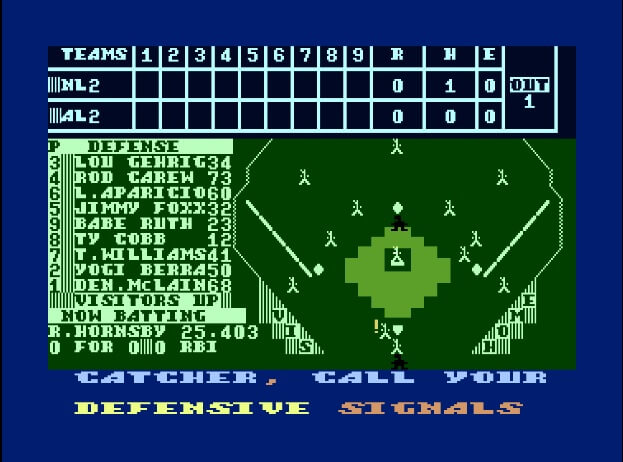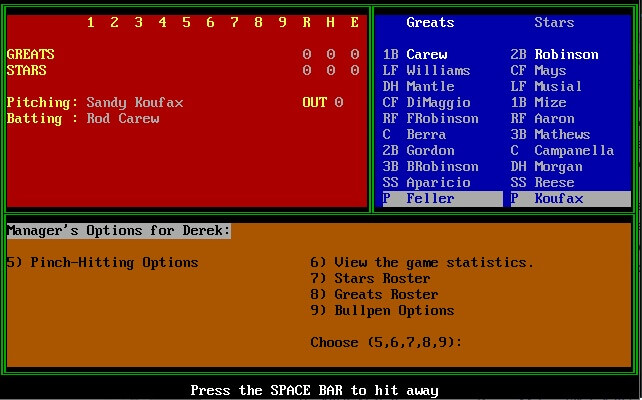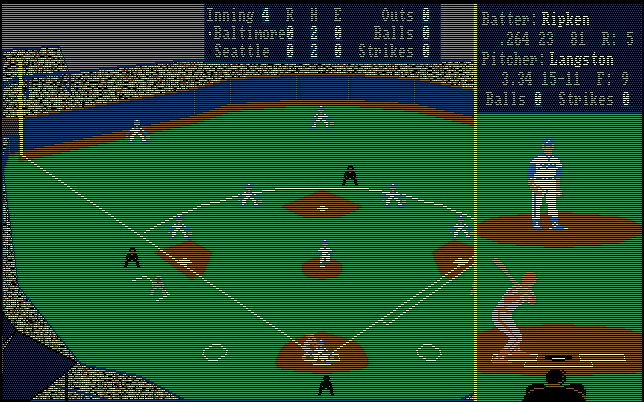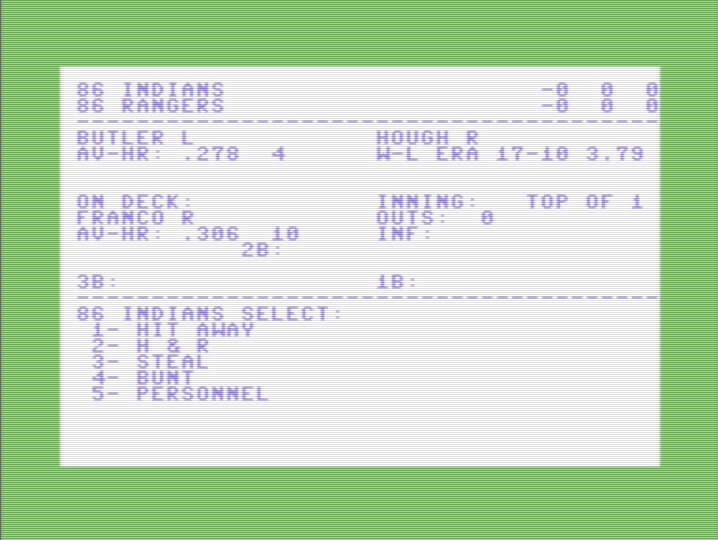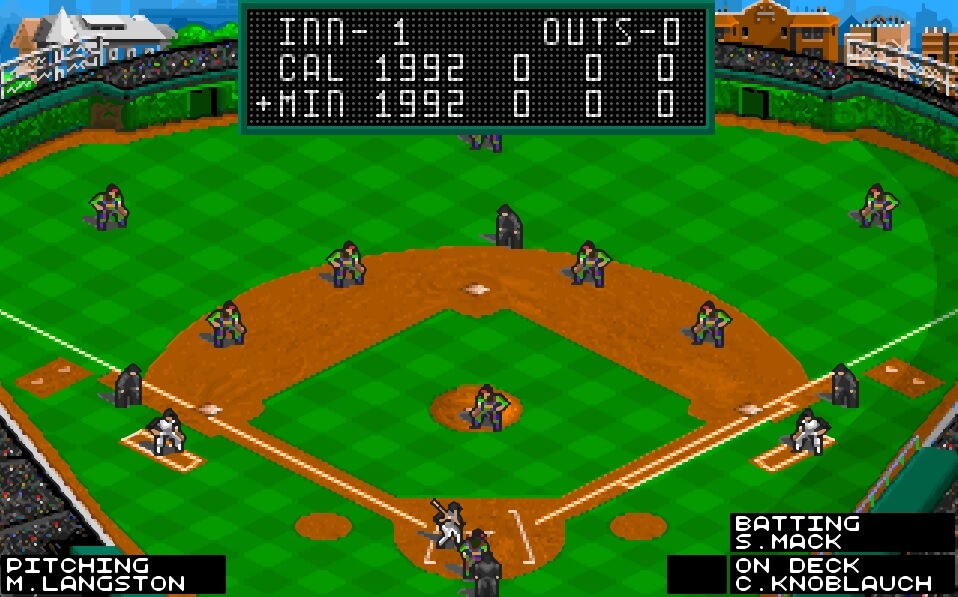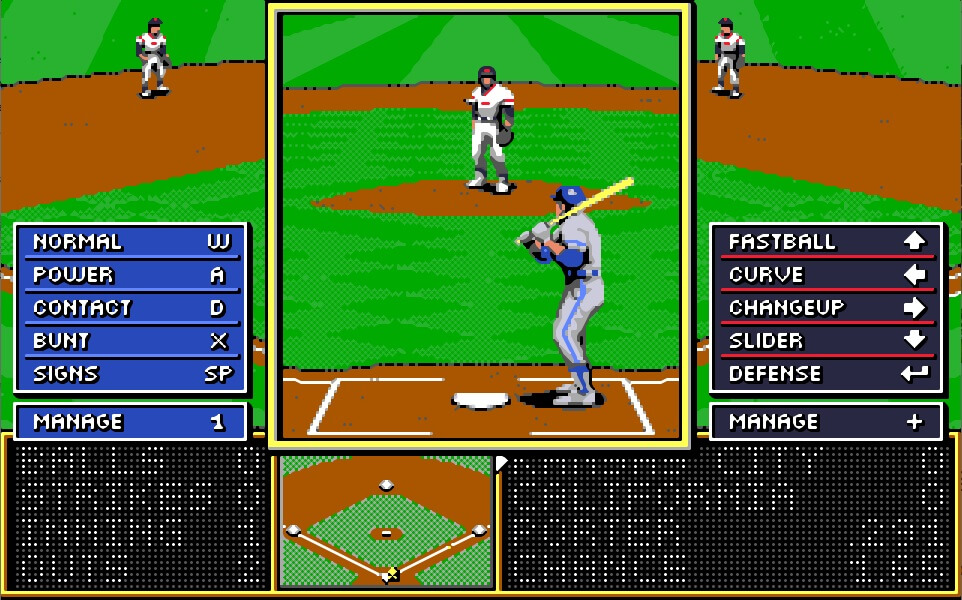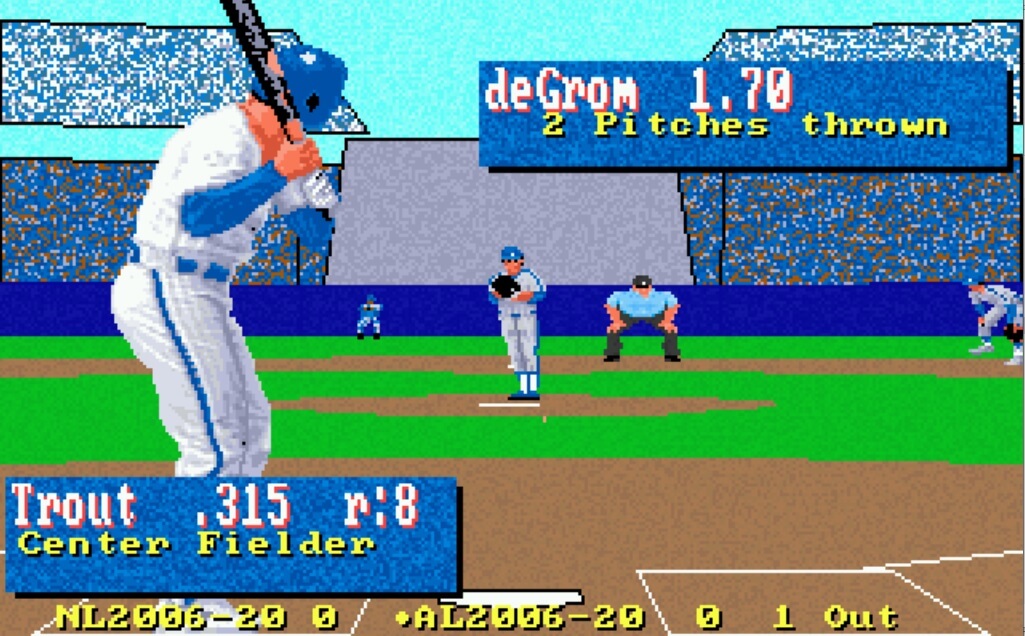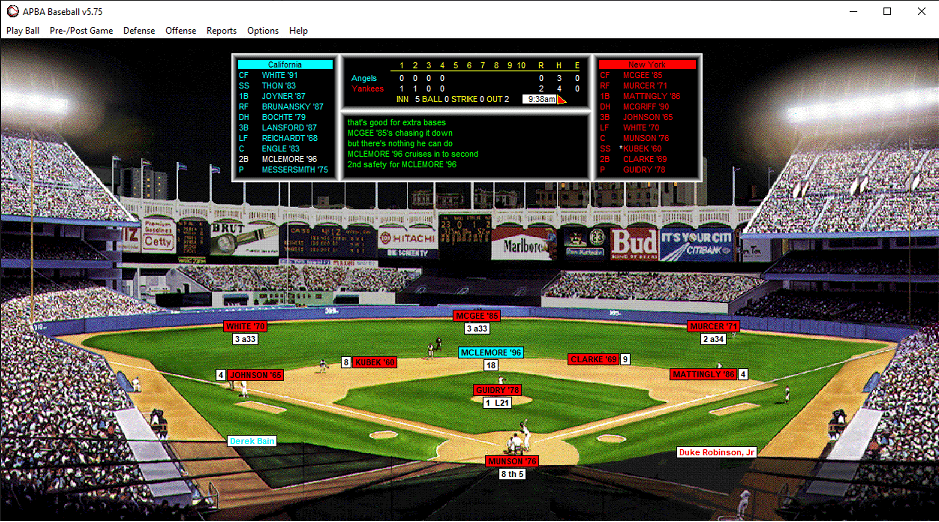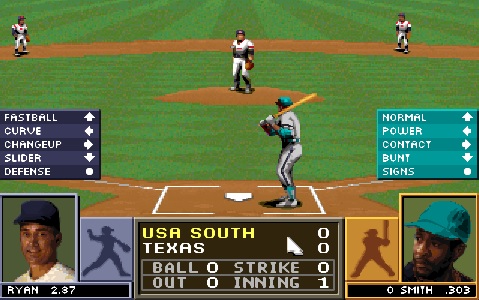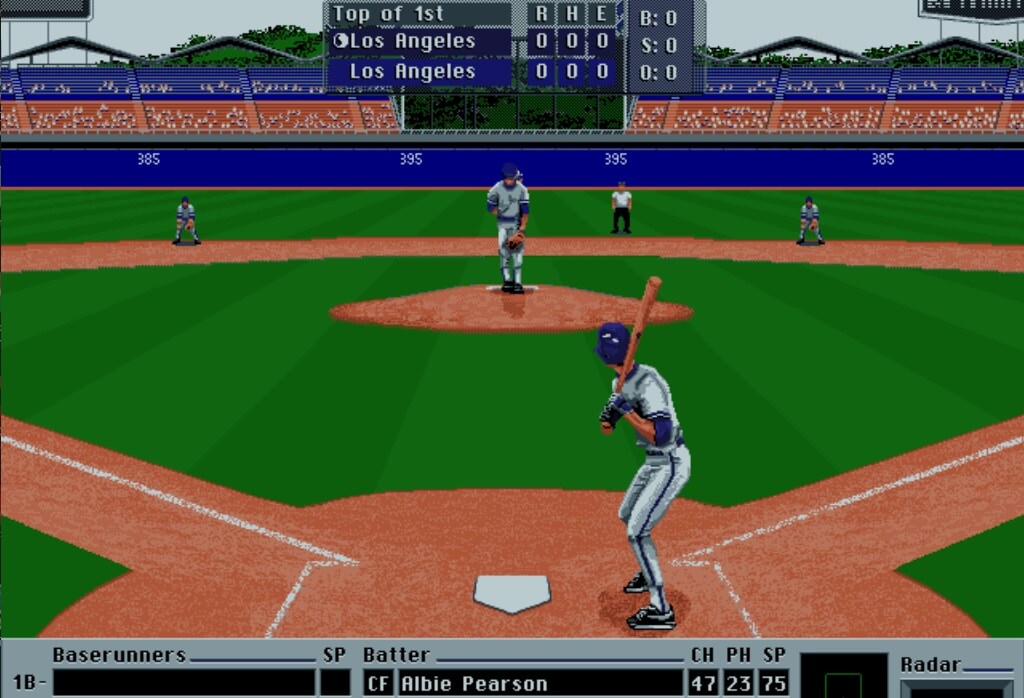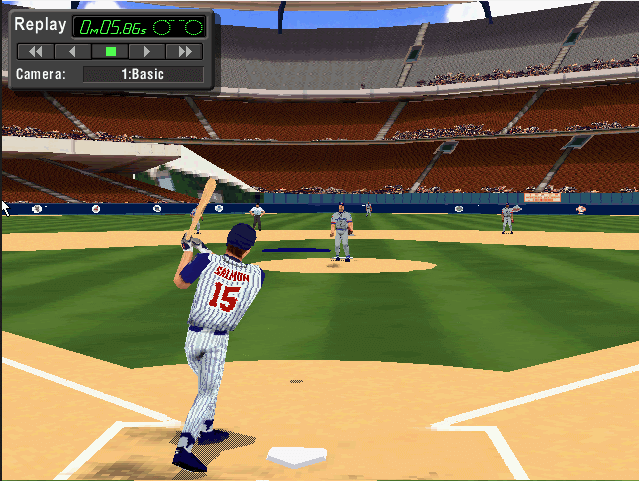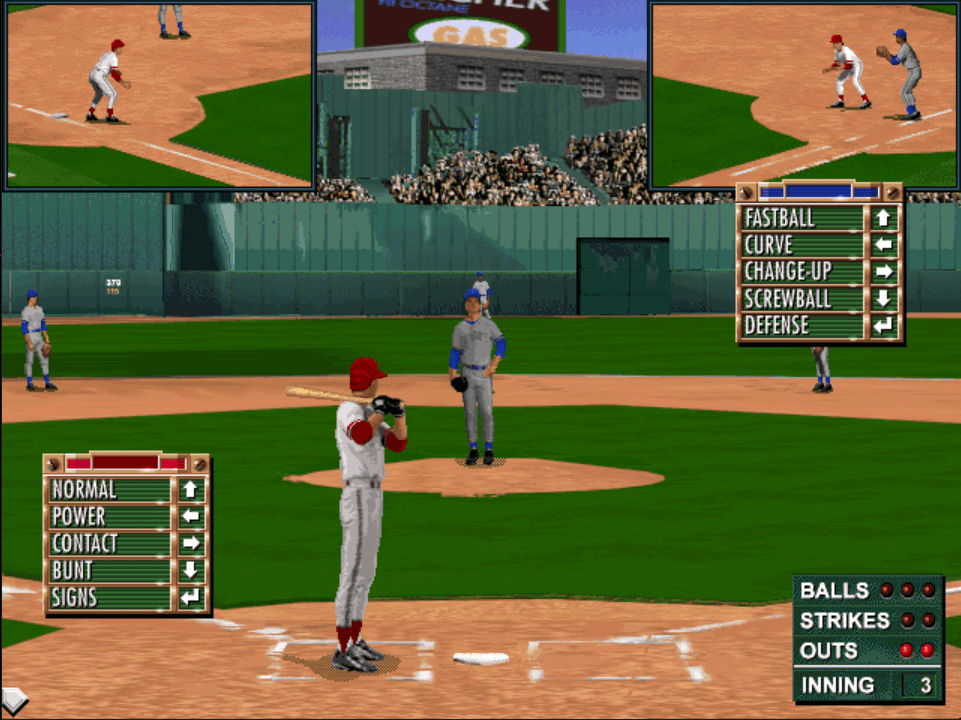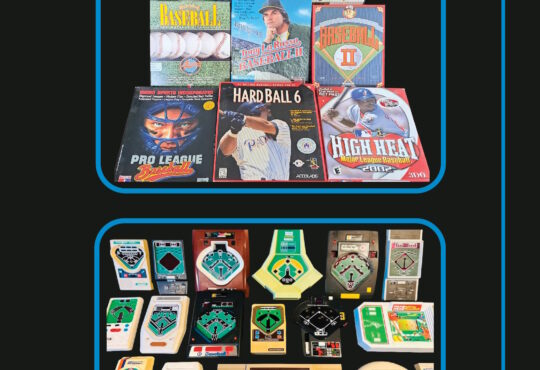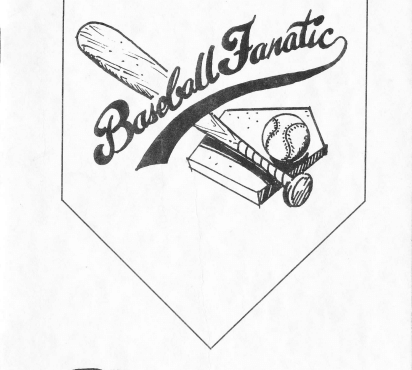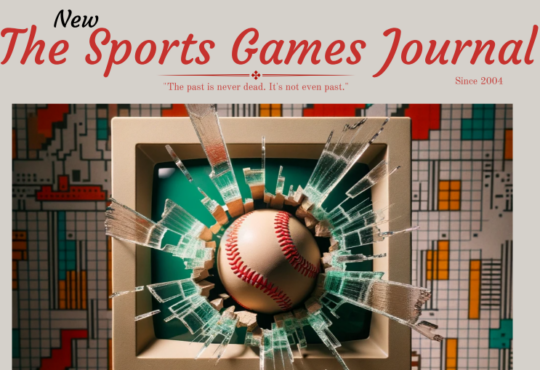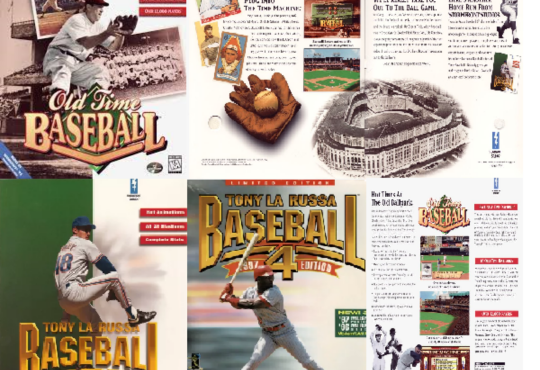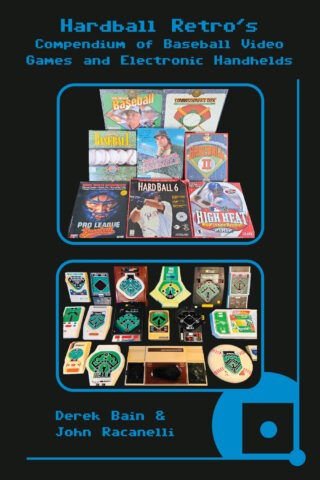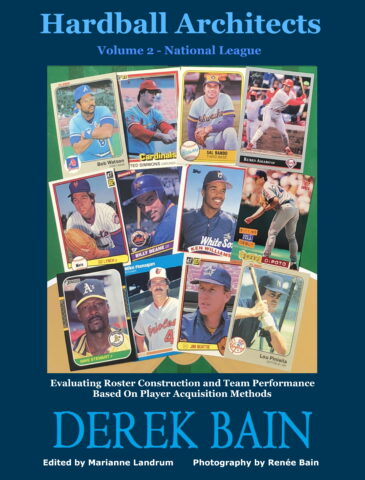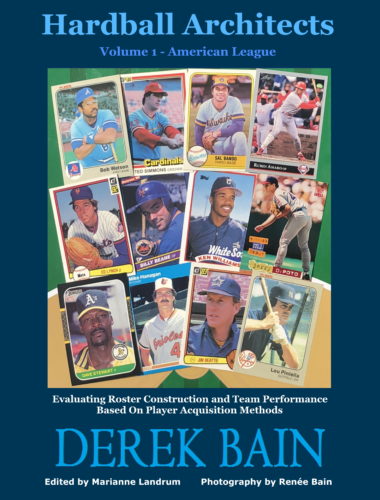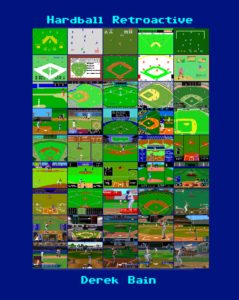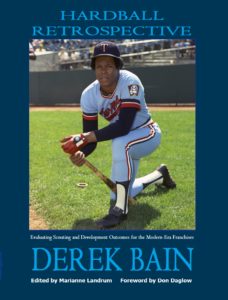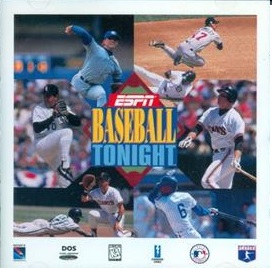
Retro Computer Baseball Game Review – ESPN Baseball Tonight
This is the sixteenth entry in a series focusing on computer baseball simulations to supplement the chapter “Play Retro Baseball Video Games In Your Browser” from my Hardball Retroactive book along with the corresponding post at Baseball Analytics. The series focuses on baseball simulations – games in which the primary emphasis is on managerial strategy and the ability to replay entire seasons with a degree of realism. Baseball video games that are strictly arcade representations of baseball (based solely on reflex and hand-eye coordination) are excluded.
IBM PC version
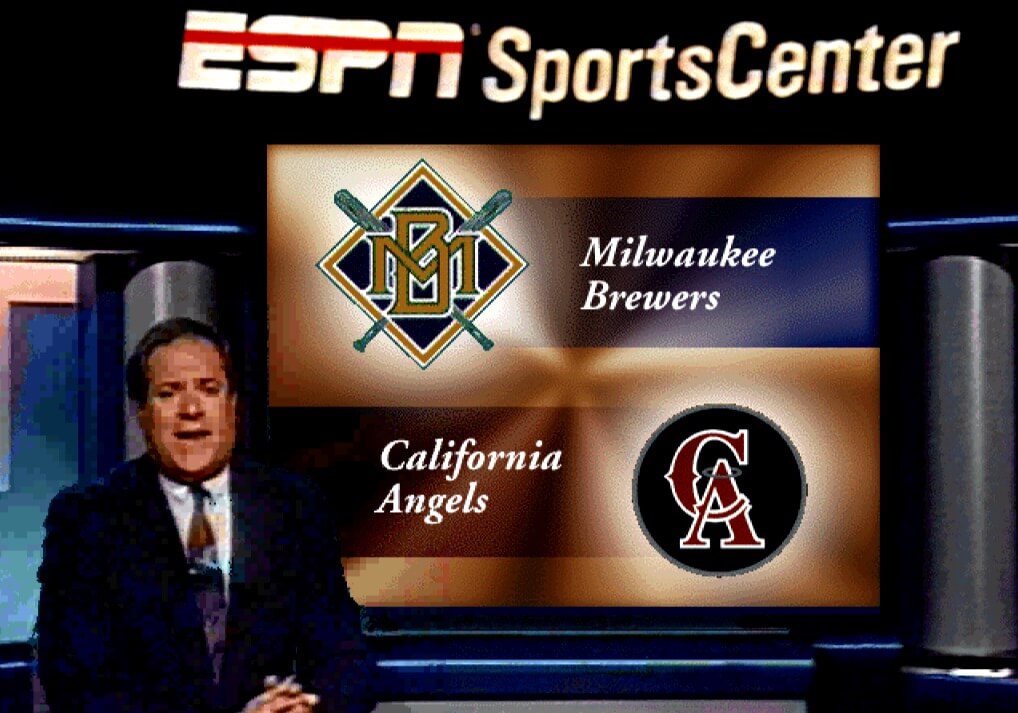
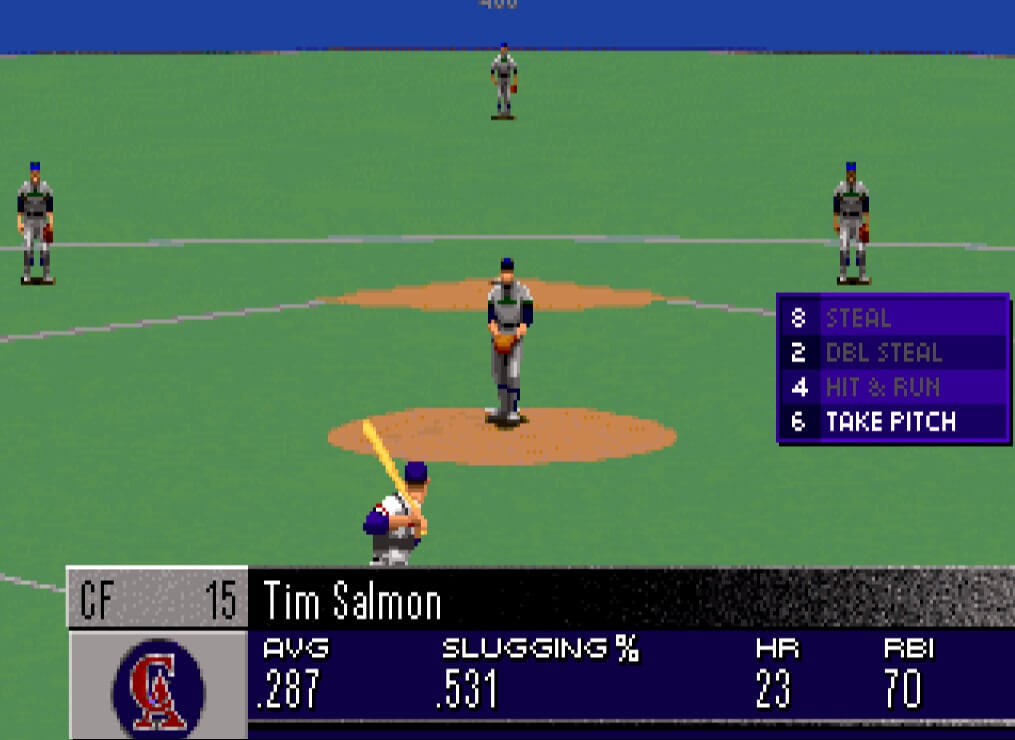
ESPN Baseball Tonight
Publisher – Sony Imagesoft
Release Year – 1994
Platforms – IBM PC
Credits
| Stormfront Studios | |
| Game Design: | Mark Buchignani |
| Baseball Engine Design: | Hudson Piehl |
| Programming: | James H. Grove III, Philip King |
| Art Direction: | David Bunnell |
| Technical Direction: | Mark Buchignani, Hudson Piehl |
| Interface Art: | Eric Nava |
| Animation: | David Clemons, Geraldine Kovats, Delphine Louie, Kimberly Moriki Zamlich, Al Roughton, Christopher Gray |
| Stadium Art: | Michael Barber, Kenn Berry, William A. Dwyer, Marina Goldberg, Hugo Kobayashi, Arturo Sinclair |
| Team Leader: | Don L. Daglow |
| Based on Original Design by: | Don L. Daglow, Mark Buchignani, David Bunnett, Hudson Piehl |
| Sound Effects: | Sean Carson |
| Original Music: | Steven Scherer |
| Voice Processing: | Andrew Boyd, Sean Carson |
| Video Processing: | Arturo Sinclair, Andrew Boyd, Sean Carson |
| Additional Programming: | Alyssa Finley, Masami Yamada, Mark Manyen, Randall Turner |
| Manual Text: | Mark Buchignani |
| Research Archivist: | Marla Cosgrove |
| Umpire: | Tony Patch |
| Stormfront Product Testers: | Steve Borstead, Stephen L. Kozlowski |
| Sony Imagesoft | |
| Producer: | Ken George |
| Lead Testing Analyst: | John Nelson |
| Quality Assurance Manager: | Dennis Clark |
| Thanks to: | Randy Thier, Greg Oberle, Mark Mutchler, Michael Hardt |
| ESPN | |
| ESPN Announcers: | Chris Berman, Dan Patrick |
| Thanks to: | Tom Hagopian, Dick Glover, Jim Noel, Ed Durso, Tanya Curry, Steve Bornstein, Kil-Jae Hong |
| STATS, Inc. | |
| STATS, Inc. | Jim Capuano, Ross Schoffleberger |
Programmer Interview
Don Daglow and the Stormfront Studios team collaborated with Sony Imagesoft on this title. He replied to a series of questions about the ESPN Baseball Tonight – PC version.
DB – Please tell me about the ESPN Baseball Tonight. Who proposed the development of this title and how did the Stormfront team along with Sony Imagesoft determine which features to keep or omit from the “Tony La Russa Baseball 2” engine? Were any features specifically added or removed in order to differentiate the products?
DD – We created the ESPN National Hockey Night game for Sony, and they were looking to build a sports line across all the major leagues that ESPN supported. We agreed to do a modified version of Tony La Russa Baseball for them to publish under the ESPN brand. We met and mutually agreed on which features to keep — they wanted a simpler game that didn’t feel like a La Russa clone. I’m afraid I don’t remember the details.
DB – Were any design choices implemented in order to mimic the console versions? While there is a “sim” component to the game, it feels like the product was catered towards arcade play.
DD -That’s accurate — the ESPN brand is about showing all the action, so what we today would call more of a console style game was the target. I don’t remember the degree to which we used the Sega Genesis version of La Russa as a template.
DB – Comparing this title to other baseball simulations, I immediately noticed the omission of box scores along with the ability to view scores or results from completed games. Was this a direct result of gearing the title towards the casual gamer?
DD – Yes, this was to be more about the gameplay of the moment rather than the long term of how stats could guide strategy. We also wanted to keep a clear differentiation between the titles.
DB – Were there any features left on the cutting room floor due to time constraints or deadlines?
DD – None that were frustrating enough for me to remember them now after 30 years.
DB – Did you or any Stormfront team members have the opportunity to interact directly with any of the on-air talent or crew from the ESPN Baseball Tonight show?
DD – No, that was handled by the team at Sony. Publishers doing this themselves when working with outside studios was already the norm in the 1990s.
Review
In the same vein as the Earl Weaver and Tony La Russa Baseball games, ESPN Baseball Tonight is a hybrid as it offers the opportunity to play an arcade-type baseball game or manage a simulation with human or computer opponents. However it differs greatly from EWB and TLBB as a number of core features that I would consider must-haves in a competent baseball sim are either de-emphasized or stripped entirely from this effort. For these reasons I strongly considered omitting ESPN Baseball Tonight along with Accolade’s later Hardball releases from my “Retro Review” series. I ultimately decided to include them for the sake of completeness while noting the differences between these entries versus pure baseball simulators.
Cranking up the game in Dosbox, the audio and video segments catch your attention immediately as the Baseball Tonight theme song blares through your computer speakers. The mouse-driven main menu facilitates batting practice, trades, viewing player statistics, league play and exhibition play. Selecting the League Play option, I immediately noted the inability to edit or manipulate my roster. As far as I can tell, there is no way to create new players or teams nor is there an option to modify existing rosters except for the “Trade Player” module. This frustrated me to no end when I purchased the title back in 1994 but I was determined to forge ahead and attempt to simulate a season. Moving on to lineup creation, you can create a default lineup and defensive positions for each team, but you don’t get to select different batting orders based on the pitcher’s hand. The default lineups and pitching rotations are riddled with mistakes. A few examples – rookie catcher Chris Turner (86 plate appearances) batting leadoff for the ’93 Angels or Jeff Bagwell hitting atop the Astros’ order instead of third or fourth. If the batting orders were computer-generated, those algorithms needed more fine-tuning to improve the realism.
Box scores? They don’t exist in this game – at all! Understanding the desire to craft a more action-based (arcade-like) game, I’m perplexed by this omission. In hindsight, perhaps a feasible compromise would have been the inclusion of a standard box score without all of the bells and whistles of the expanded (USA Today-style) box scores. While hardcore users would likely miss the detailed record of each game, my assumption is that the casual hardball fan would want the option to peruse the results of the contest. Given the available storage mediums at the time, I would expect at least the option to save box scores to a hard drive. This missing feature along with the lack of a player editor nearly led me to exclude the game from my review list.
Quirks – I found that it’s possible to substitute a pitcher into the game after he’s been removed. After the regular season ended, I selected the Start Playoffs option in the schedule. Then I realized that I forgot to grab screenshots of the final regular season league leaders. Too late! Those statistics are wiped out. During the playoffs I noticed that the graphic displaying the current batter’s statistics failed to calculate batting average correctly (all hitters were listed with a .000 BA). It is possible that a subsequent patch remedied some of these issues but I was unable to locate this file a quarter-century after the game was released.
1993 Season Replay
ESPN Baseball Tonight game comes with the 1993 and 1994 seasons, so I decided to simulate both seasons using the default lineups and pitching staff configurations with injuries enabled. Working in chronological order, I selected “Start New Season” from the main menu, chose 1993 from the available leagues and reviewed the settings (DH for the American League, number of games in each playoff round, etc.) I browsed ahead on the schedule, choosing a game just prior to the All-Star Break (July 16) and all of the games up to that point were simulated in under 15 seconds!
For the Mid-Summer Classic, I opted to use rosters based on the simulated stats up to that point in the season. The results were an interesting mix of players that I expected to make the team (Barry Bonds, Ken Griffey Jr., Tony Gwynn, Greg Maddux) along with a group that hadn’t quite reached All-Star status during their careers (Mike Pagliarulo, Troy Neel). The contest was held in Baltimore at the new home of the Orioles, Camden Yards. The National Leaguers jumped out to a 4-0 advantage in the opening frame but the home team returned fire with 3 runs of their own. Fred “Crime Dog” McGriff rocked a pair of home runs including a grand slam and Lenny “Nails” Dykstra added a 3-run blast as the Senior Circuit opened up a 14-3 lead with a 10-run third inning against AL starter Ben McDonald and Kevin Tapani. “Junior” followed singles by Kenny Lofton and Roberto Alomar with a deep drive into the center field seats in the bottom of the fifth to help the American Leaguers close the gap to 15-9. Twice in the fifth inning, Roberto Alomar fielded a ground ball with runners on first and second. He stepped on the bag and proceeded to throw to third (the runner was safe both times) instead of wheeling and throwing to first. This move cost the American League All-Stars a pair of runs. Griffey mashed a two-run tater to center after Alomar walked with two outs in the fifth, running the score to 17-11 after five complete frames. Wayne Housie, apparently batting .984 on the season (?), replaced Barry Bonds in the NL lineup and knocked in one of the six runs that they tallied against David Cone and Jesse Orosco in the top of the sixth. Every pitcher yielded multiple hits and runs although I have no way to document this (no option to view box scores?). The game concluded with Pedro Martinez on the hill for the National League. Griffey was caught stealing third with two outs and his team trailing by 12 runs! Guess he wanted to catch an early flight back to Seattle after this debacle. The final score (25-13!) appears, Dan Patrick signs off and you are promptly returned to the main menu. Besides the lack of a box score to peruse after the fact, this would have been a great place to deliver a highlight reel or a “scores from around the league” segment.
I had the computer simulate the remaining regular season contests along with the Championship Series in both leagues. The Braves swept the Phillies and the White Sox outlasted the Orioles to advance to the World Series. I elected to manage Atlanta while Gene Lamont skippered the Southsiders. The team’s aces squared off in Game 1 – “Black” Jack McDowell on the hill for the hometown Pale Hose against the “Professor”, Greg Maddux. “Neon” Deion Sanders led off the game with a deep drive to center. Sensing a three-base hit, he sprinted out of the box but Lance ”One Dog” Johnson dove at the last moment and made an incredible over-the-shoulder catch for the first out of the contest! Jeff Blauser ripped a single to center and Fred McGriff followed with a two-base knock, placing a pair of runners in scoring position for the heart of the Braves’ order. Dave Justice beat out a slow roller to short which allowed Blauser to score. Ron Gant walked to load the bases and Terry Pendleton delivered McGriff on a sacrifice fly to center. McDowell nearly escaped the threat when Joey Cora gloved Mark Lemke’s weak roller towards second, but Gant snuck into second before Cora’s throw reached Ozzie Guillen. Damon Berryhill cashed in a pair of runs with a two-run double up the left-center field gap. Maddux lifted a pop-fly into short right field which landed between Cora and the right fielder, Ellis Burks, extending Atlanta’s lead to 5-0. Sanders popped out in foul ground on the third base side as an exasperated McDowell finally retired the side. Johnson doubled to left-center field to kick off the home half of the first inning. Tim “Rock” Raines laced a rocket to left but Johnson wisely held up at third with his squad behind by 5 runs. Frank Thomas aka “The Big Hurt” knocked in the first ChiSox run with a hot smash to left field. Robin Ventura coaxed a base on balls to bring Burks up to the dish with the sacks juiced. Lemke snared a soft liner up the middle for out #1. Maddux exhaled and then proceeded to whiff the Sox mustachioed backstop, Ron Karkovice. Cora uncorked a long fly to right, driving Justice to the warning track and sending the home crowd into a brief frenzy before the ball settled into the right fielder’s glove for the third out of the frame. Donn Pall relieved McDowell in the fifth after he yielded his 12th hit of the game to put runners on second and third with no outs. Justice delivered an RBI groundout to increase Atlanta’s advantage to 6-1. The Sox scratched across a run in the bottom of the ninth but Kent Mercker extinguished the threat with a punch-out of third baseman Robin Ventura.
Tom Glavine took the hill against Alex Fernandez in Game 2. Ron Gant doubled to center to drive home Otis Nixon with the first run of the contest. Terry Pendleton ripped a two-base hit off the base of the right field wall in the fourth, scoring Dave Justice all the way from first base. Chicago tied the score in the bottom of the fourth. Frank E. Thomas tripled to center field to plate Lance Johnson. Tim Raines followed with a single back through the box. “Neon” Deion Sanders laced an opposite-field double down the left field corner as the Braves reclaimed the lead in the visitor’s fifth. Atlanta tacked on a run in the sixth when Ellis Burks booted Damon Berryhill’s single and then made an errant throw to third which skipped past Robin Ventura, allowing Mark Lemke to score. Norberto Martin lofted a pinch-hit sacrifice fly to pull the Pale Hose within a run in the bottom of the seventh. “One Dog” Johnson delivered the tying run with a sharp single to left, knocking Glavine out of the game. Thomas greeted Steve Bedrosian with a two-bagger up the left field gap and Johnson scooted around the bases to give the ChiSox the lead, 5-4. Pendleton blooped a base hit against Fernandez and Lemke blistered a double up the right-center field gap. Sox manager Gene Lamont summoned reliever Donn Pall who promptly escaped from the frame when Sid Bream hit a foul pop to third and Nixon grounded out to Ventura. In the top of the ninth, Roberto Hernandez yielded a leadoff single to Sanders. Fred McGriff lashed a safety between first and second, sending “Neon Deion” to third with nobody out. Gant coaxed a walk to load the bases. Justice whiffed but Pendleton came through with a base hit that dropped in between the right fielder (Burks) and the second baseman (N. Martin) to knot the game at 5-5. Hernandez was lifted in favor of veteran right-hander Jose DeLeon. Lemke hit a can of corn to Johnson, but McGriff tagged up and slid safety under the tag as the Braves regained the advantage, 6-5. The White Sox came to bat in the home half of the ninth. Mike Stanton got two quick outs but Johnson dunked a base hit into right field just over the outstretched glove of Lemke. Greg McMichael entered the match and got Thomas to bounce a one-hopper to Pendleton, who fired wildly to second. With the tying run only 90 feet away and the potential winning run standing on second, McMichael was ordered to issue an intentional pass to Tim “Rock” Raines. Robin Ventura strolled to the dish with the sacks juiced and the home crowd was whipped into a frenzy. Unable to find the strike zone, McMichael hurled four consecutive balls to walk Ventura as the White Sox tied the game at 6-6. Jay Howell jogged in from the pen. Burks got the green light on a 3-0 offering and smashed a hot grounder up the middle. Jeff Blauser fielded and flipped to Lemke for the second out. The relay throw appeared to nab Burks but the umpire ruled “safe!” and the ballgame ended with the Sox claiming a 7-6 victory! Atlanta argued vehemently and lodged a formal protest with the League, but to no avail.
The Series was knotted at one game apiece and I fully expected the action to move southeast to Atlanta. Apparently the schedulers did not agree with me as I fired up Game 3 to find the White Sox listed as the home club. John Smoltz got the call for the Braves while the ChiSox countered with Wilson Alvarez. Smoltz exited the contest after injuring himself warming up in the top of the second. He was later diagnosed with sore ribs and ruled out for the remainder of the series. Southpaw Kent Mercker replaced “Smoltzie” on the bump. The contest remained a pitcher’s duel into the bottom of the sixth when Mercker loaded the bases on walks and Chicago pushed a run across on a fielder’s choice as Jeff Blauser tried for a 6-4-3 double play instead of throwing home for the force play. Alvarez held the Braves hitless through six frames but manager Gene Lamont removed him due to a high pitch count. Veteran righty Jose DeLeon came on in relief and issued a base on balls to pinch-hitter Javy Lopez. After striking out Ryan Klesko (who batted for reliever Jay Howell), third-sacker Robin Ventura made a diving stab of a line drive off the bat of Otis Nixon to preserve the no-no with one out in the seventh. Blauser followed with a slow roller to shortstop Ozzie Guillen for an infield hit and Fred McGriff rapped a base hit up the middle to load the bases. Ron Gant busted out the boom-stick, launching a long ball to right field for a grand slam! DeLeon recovered to retire David Justice on a fly ball to right, but Atlanta suddenly held the 4-1 advantage. Side-arming right-hander Greg McMichael entered the game and retired the Sox in order to secure the victory as Atlanta went ahead two games to one.
Game 4 – wait, now we’re in Atlanta?! Yes, the Series has finally shifted to Georgia albeit one game later than expected. The young left-hander, Steve Avery, took the ball for the Braves while veteran right-hander Tim Belcher got the nod for the ChiSox. Terry Pendleton tomahawked a two-run shot over the right-center field fence to stake Atlanta to an early lead in the bottom of the second. Belched yielded a 442-foot blast into the center field bleachers by “Neon” Deion Sanders leading off the fifth frame. Avery worked his way out of a jam in the top of the seventh. With Sox on the corners, the southpaw whiffed pinch-hitter Bo Jackson and retired Ozzie Guillen on a harmless comebacker. Mark Lemke tallied an insurance run against reliever Jose DeLeon in the bottom of the eighth when he beat out an infield hit to short, scoring Fred McGriff. Steve Bedrosian twirled two hitless innings to close out the contest, combining with Avery to shut out Chicago. The Pale Hose managed only three hits against Avery and trailed Atlanta 3-1 in the Series with the top of the each club’s respective rotations set to square off in Game 5.
Otis Nixon’s fleet feet contributed to Atlanta’s first run of the game as he legged out an infield single to the shortstop, swiped second and advanced to third when Mike Lavalliere’s throw sailed into center field. Jeff Blauser promptly laced a liner to left and Nixon trotted home. “Black” Jack McDowell retired the heart of the Braves’ order to escape further damage. The swift center fielder smacked a single to his opposite number in the second frame to knock in Terry Pendleton. Chicago loaded the bases against Greg Maddux in the top of third but only mustered a lone tally on a fielder’s choice. Fred McGriff launched a long ball to left-center leading off the home half of the third and the bottom of the Braves’ batting order tacked on three additional runs for a 6-1 lead. Sox skipper Gene Lamont displayed no sense of urgency as he left McDowell on the mound instead of seeking an assist from his relief corps. Chicago battled back in the fifth, scoring a pair on a fielder’s choice groundout by Joey Cora and a long double over Nixon’s head off the bat of Ozzie Guillen. Maddux departed with a 6-3 advantage after hurling 108 pitches in 5 1/3 innings while McDowell lasted five frames, replaced by Pete Smith and Jose DeLeon, respectively. In the top of the seventh, the Sox crept closer on a two-base knock by Ellis Burks and a single by Cora. Southpaw Mike Stanton jogged in from the ‘pen to take over for Smith. He induced a harmless pop fly by Guillen and then Lamont signaled for Bo Jackson to pinch-hit for Lavalliere. Atlanta countered with right-hander Jay Howell. On a 1-2 delivery, the slugging former multi-sport star swung and missed, and the inning ended when Damon Berryhill gunned down Cora attempting to steal second! Dave Justice plated a couple of insurance runs with a two-run single off Donn Pall in the bottom of the eighth. Ron Gant ripped a base hit to left and Pendleton followed with a hot smash up the middle as the Braves took a commanding 10-4 lead. Atlanta emptied the bench with defensive changes in the ninth. Greg McMichael pitched the final inning and got Guillen on a fly ball to right field for the last out of the Series. The Braves celebrated their victory and took turns hoisting the World Series trophy high above their heads as their fans hollered enthusiastically.
Ratings
Graphics – [4] – The batter/pitcher matchups, ball-in-play camera angles and animations are patterned closely after the Tony La Russa Baseball series. An instant replay option allows the user to review the previous play in super-fast, regular speed or frame-by-frame, but only from the original angle (you can’t switch cameras, zoom in/out, etc. like EWB2 or the FPSBB series). A scroll option facilitates access to sections of the ballpark which were not in the original shot (left or right field corners, or the outfield scoreboard / upper deck). In-game menus are accessible via the ESC key and the on-screen statistical displays look similar to the ESPN broadcasts from that era.
Sound – [3] – The crowd will boo or cheer at the appropriate intervals and there is an ambient crowd noise throughout the game. The sounds of the crack of the bat and the ball popping into the mitt are realistic.
Strategy – [3] – Standard options are available here. Bases empty choices are limited to pitching around the batter or issuing an intentional walk. With a runner on base, the defense can elect to pitchout or toggle the hold runner / play off the bag option in addition to the pitch around and intentional walk selections. On offense, with no runners on base, the only option is to take a pitch. Once you have baserunner(s), your variety increases: steal, double steal and hit & run. You can customize the defensive positioning for each fielder after every pitch or leave them at their default locations. Double-switch rule is offered along with the usual substitution options. There is no indication when a replacement is playing out of position.
Artificial Intelligence – [1] – The computer manager usually replaced his pitcher at the appropriate instances. However on several occasions the AI waited until the score was fairly lopsided before pulling the trigger. A number of offensive player substitutions were questionable such as swapping out a veteran or star player in a tight contest for a youngster with hardly any big league experience.
Box Score – [1] – There are no box scores available during or post-game.
Rosters – [1] – Player names and statistics are licensed from the 1993 and 1994 seasons. Unfortunately you are unable to edit rosters, draft players or create your own teams. The trade function is the only means of transacting player movement in this game. If player ratings exist, there is no way to edit them.
Statistics – [2] – In league play, you can display the historical statistics for the given season or the simulated stats through the current (scheduled) date. No advanced or split stats here – your options are constrained to at-bats, runs, hits, doubles, triples, home runs, RBI, stolen bases and batting average for offense while the pitching side shows wins, losses, ERA, saves, innings pitched, complete games, strikeouts, walks and shutouts. The user can switch between individual and team leaders. There is no ability to print or export results.
Usage/Injuries/Ejections – [1] – Injuries (on/off) are listed in the menu although I don’t recall encountering any notifications during the game in which I managed. Pitcher stamina appears to be tracked based on the comments below the current pitcher’s name when you visit the mound. Without having access to the manual, I’m not sure if ejections are possible and whether player usage is monitored during league play.
Ballparks / Park Factors – [2] –
The game comes with 15 ballparks (circa 1994) and a generic stadium. Graphics are rendered in sufficient detail. I’m not certain if park factors come into play. In the stadium selection screen, I noted that temperature, wind, humidity and altitude are documented along with each park’s dimensions.
Commentary – [2] – Dan Patrick handles the play-by-play commentary while Chris Berman hosts the pre- and post-game show. Player names are not implemented so Patrick refers to them by position – “Now batting, the center fielder…” Of course strikeouts are described with Patrick’s trademark call – “The whifffffffff”.
Scale: Ratings from 1 (worst) to 5 (best)
ESPN Baseball Tonight – Total Score: 20 out of 50
Observations
Although it was derived from the fine Tony La Russa Baseball series, ESPN Baseball Tonight is not intended for serious simmers. Only recommended for a quick fix of nostalgia from the classic intro theme music to Dan Patrick’s dry delivery.
Please add a comment below if you spent a significant amount of time and/or have any recollections of ESPN Baseball Tonight.
Screenshots
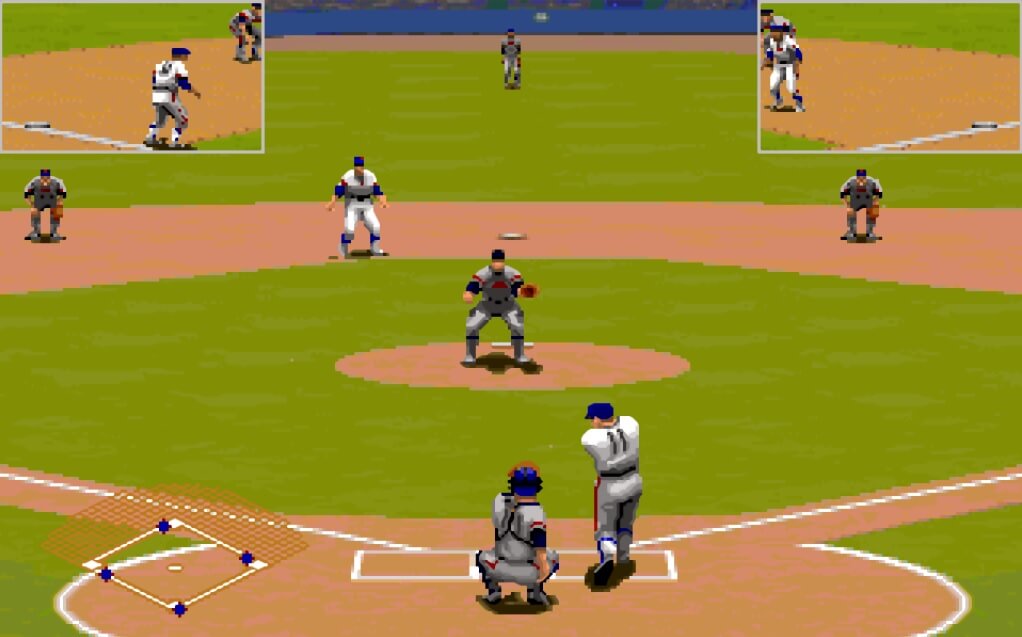
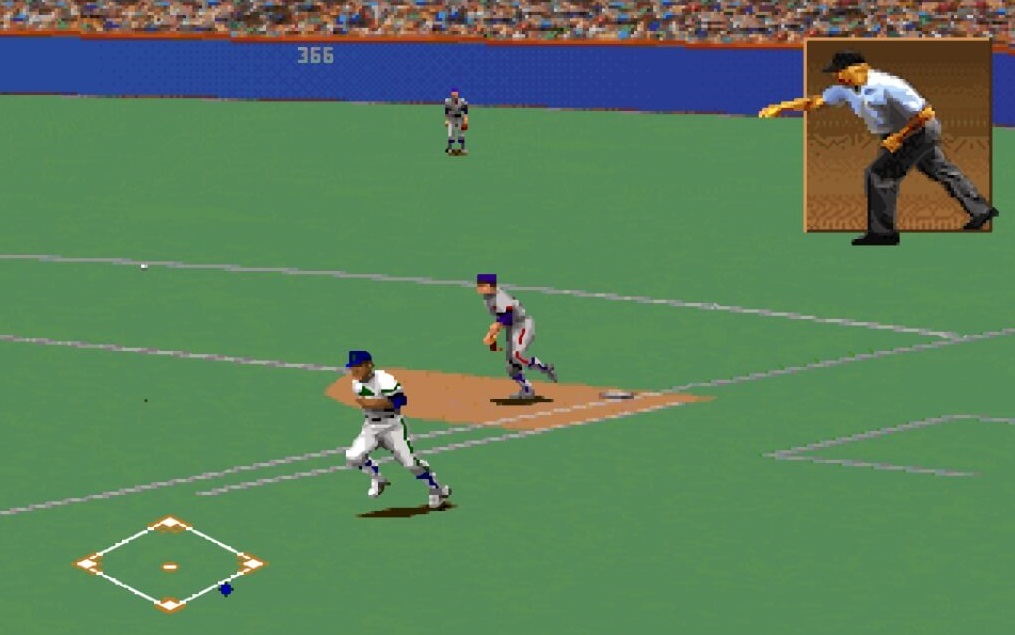
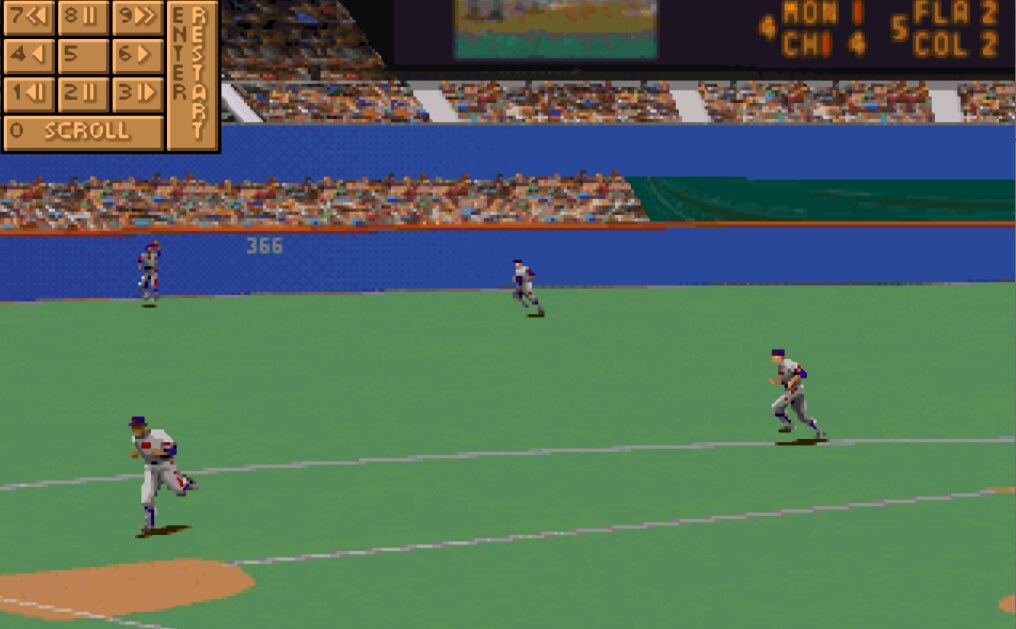
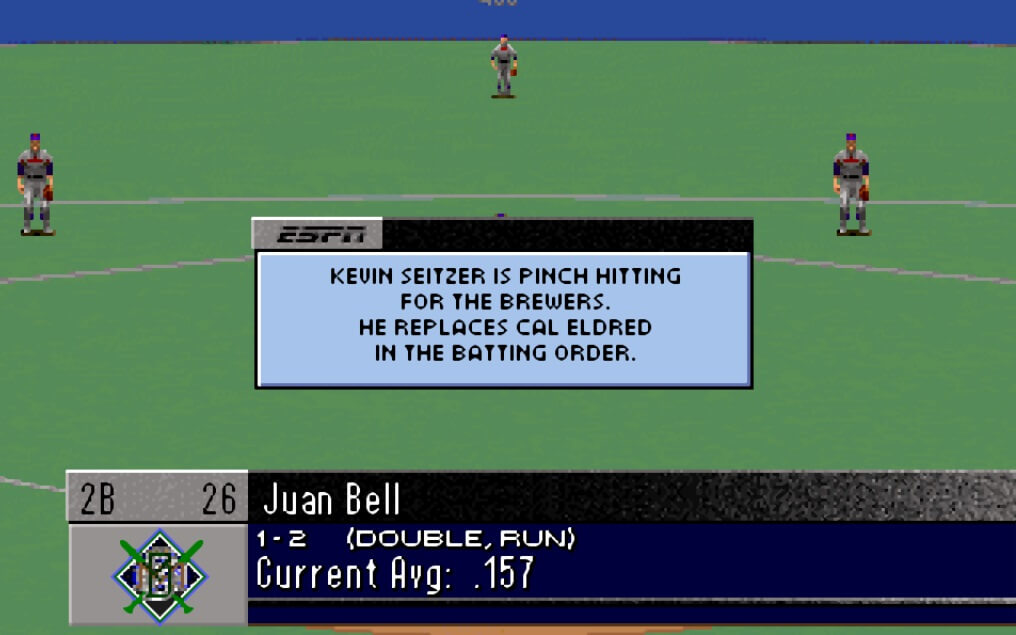
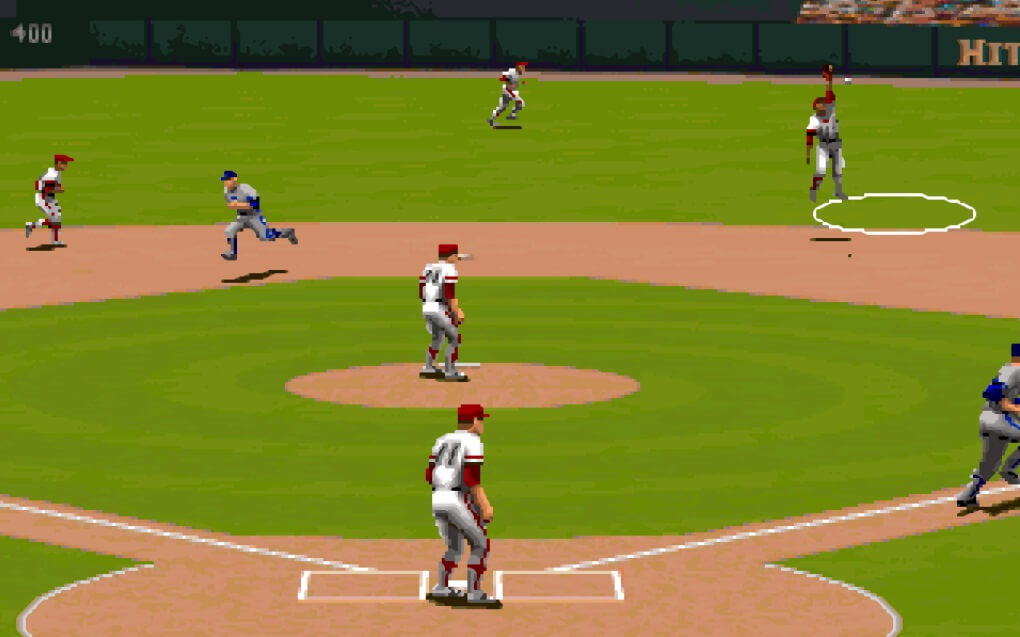
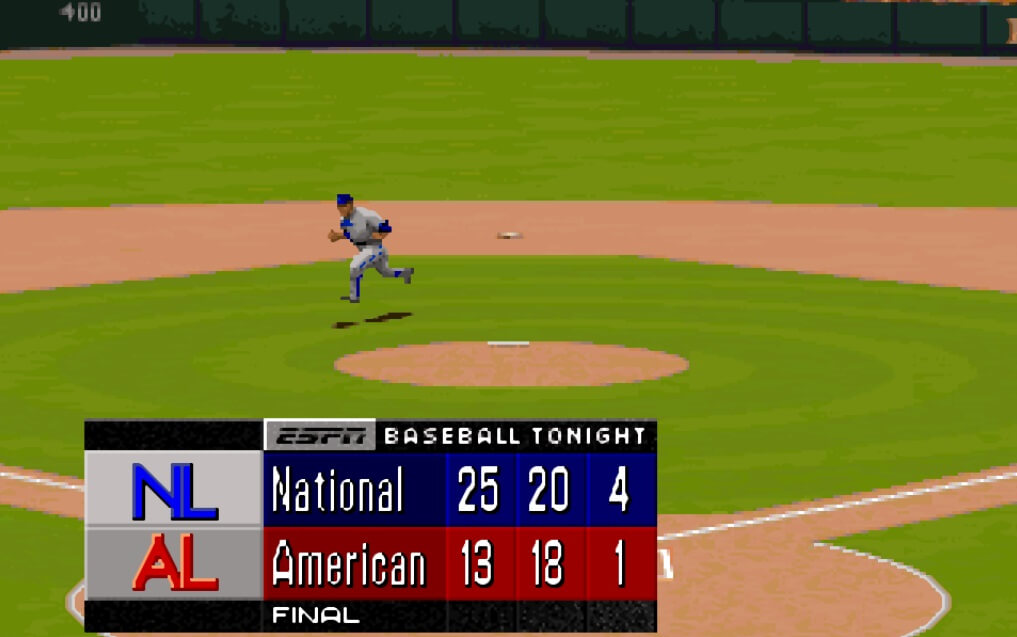
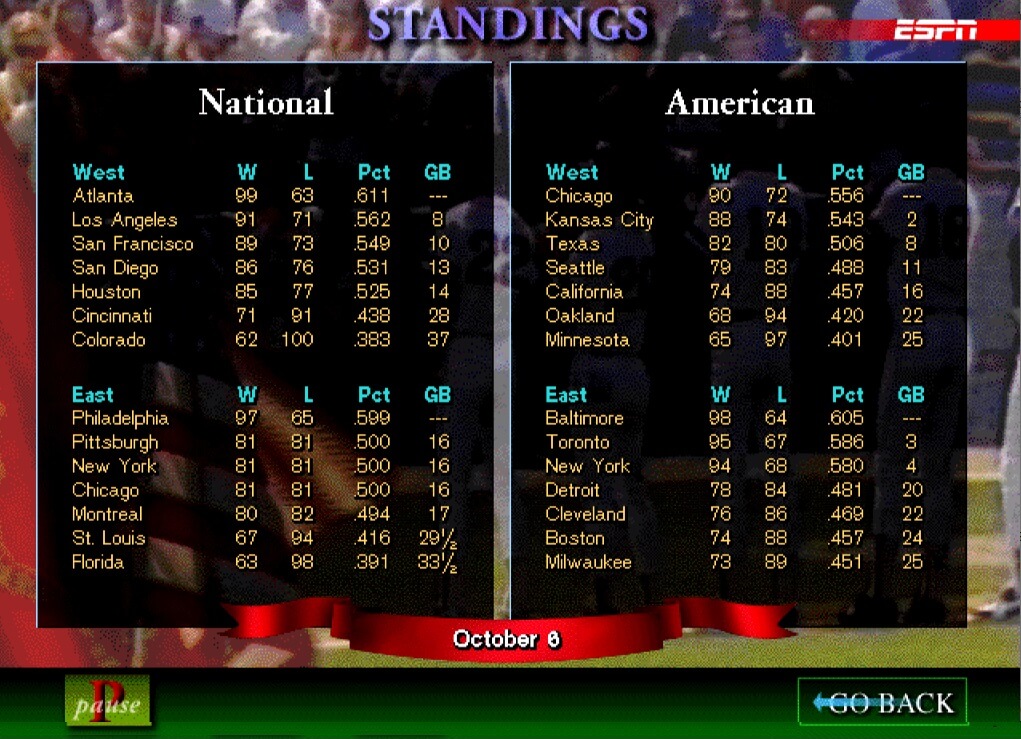
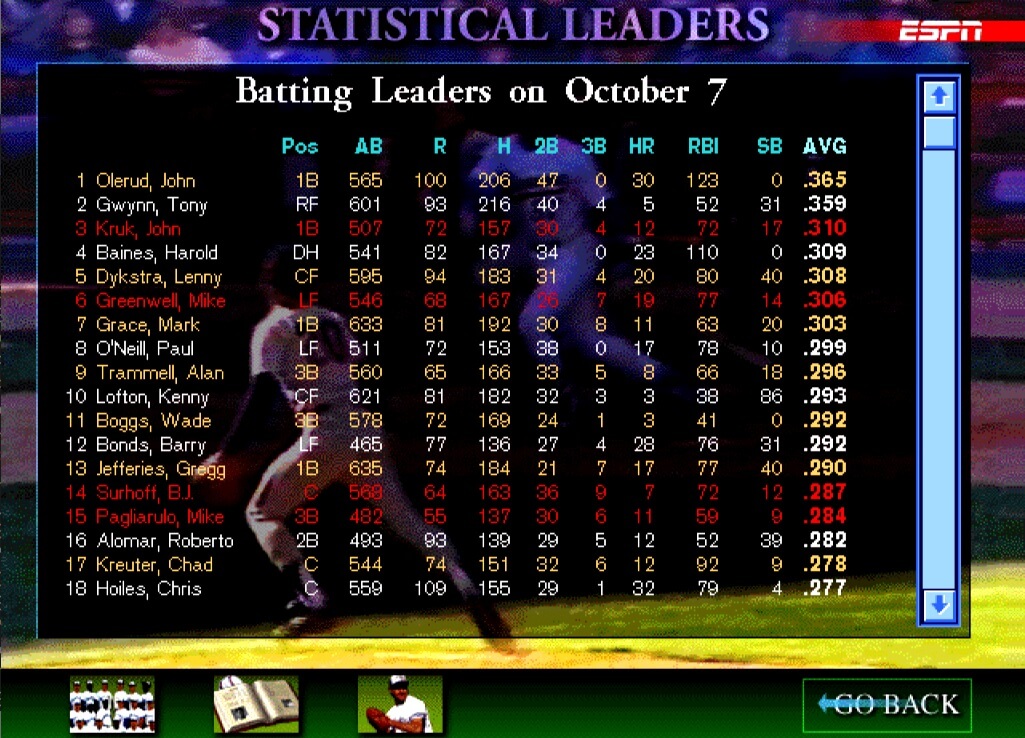
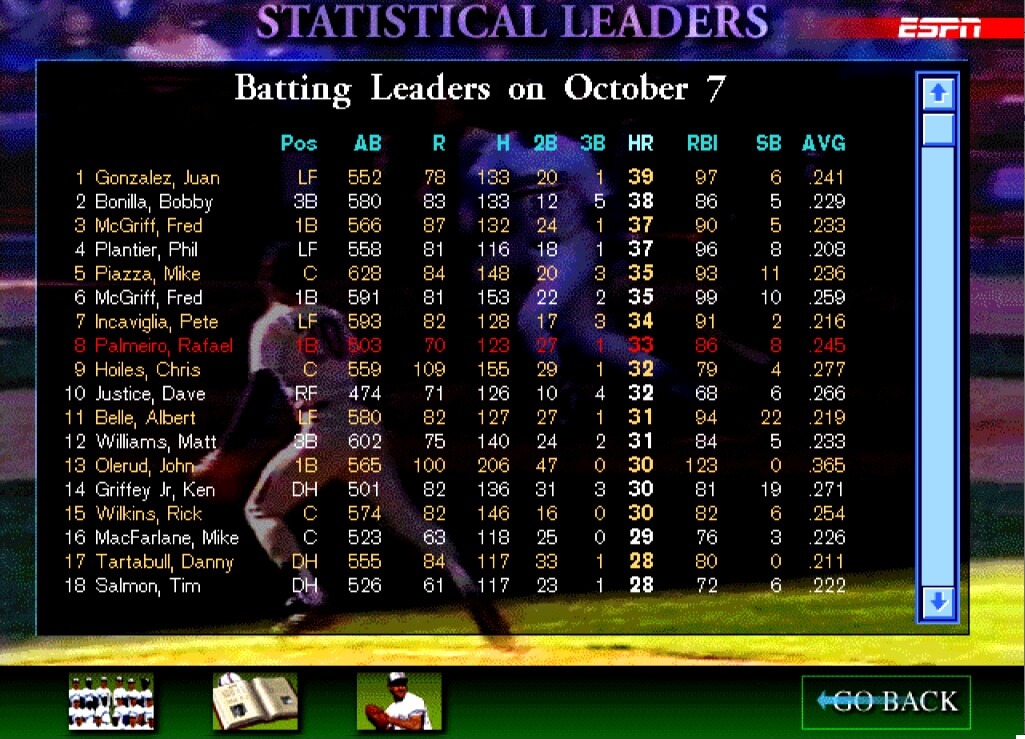
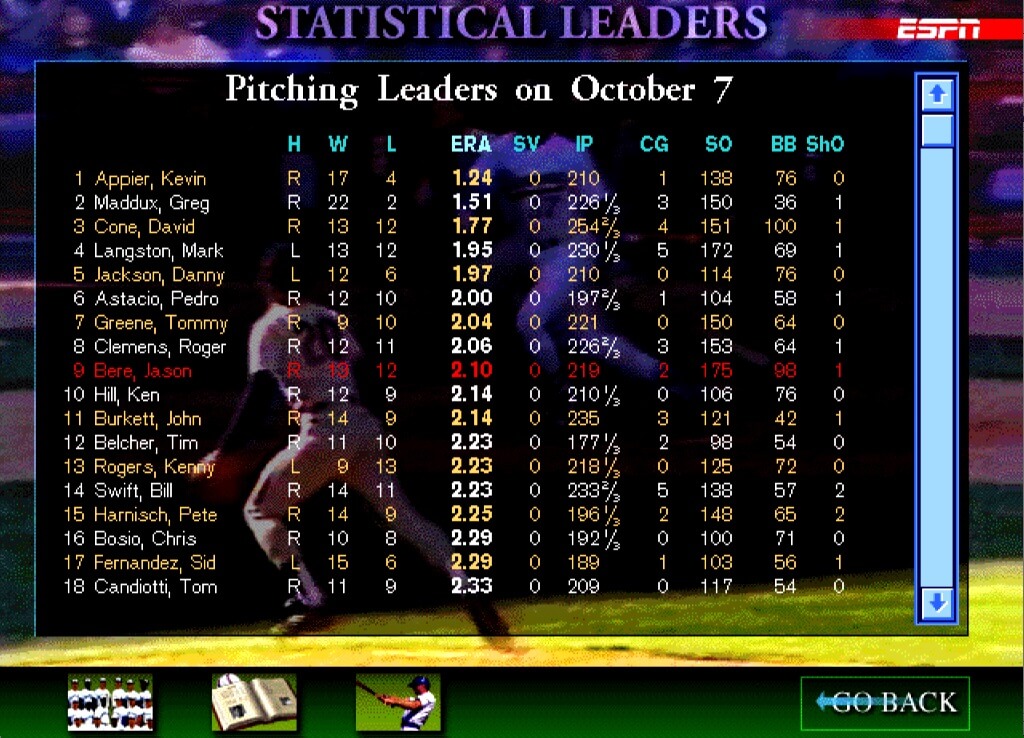
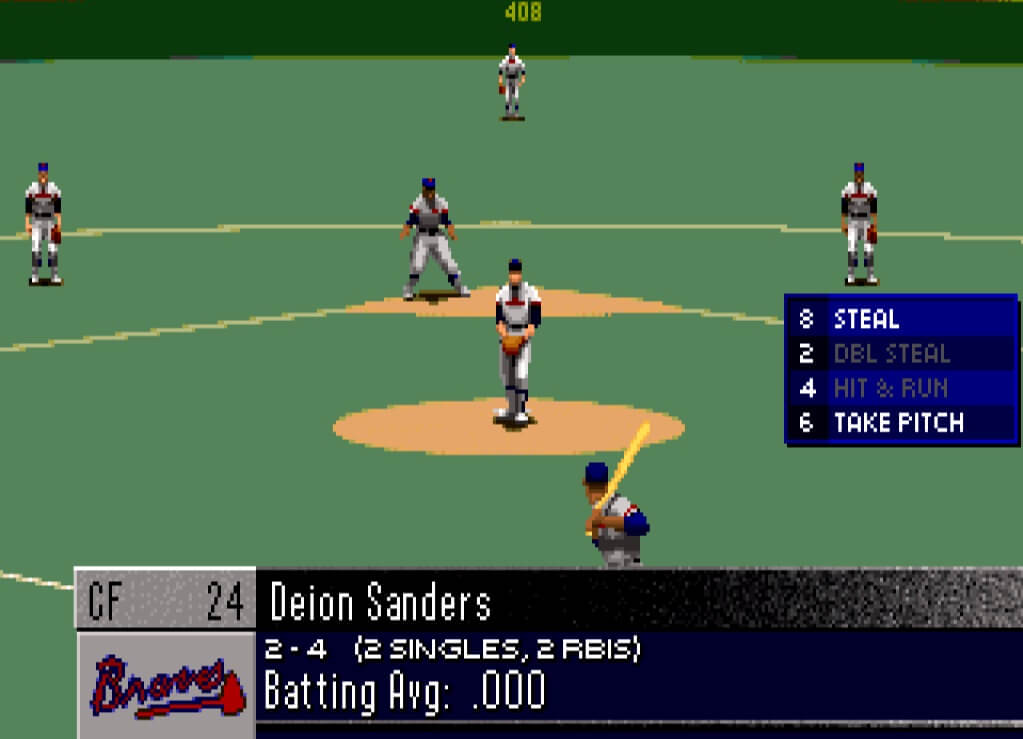
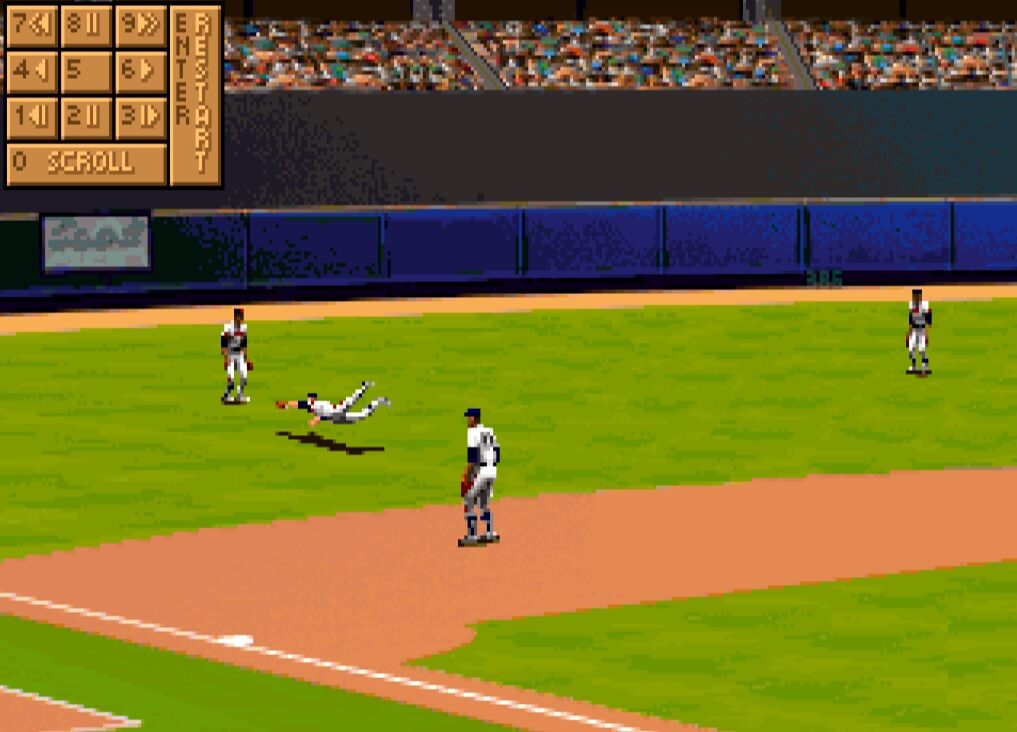
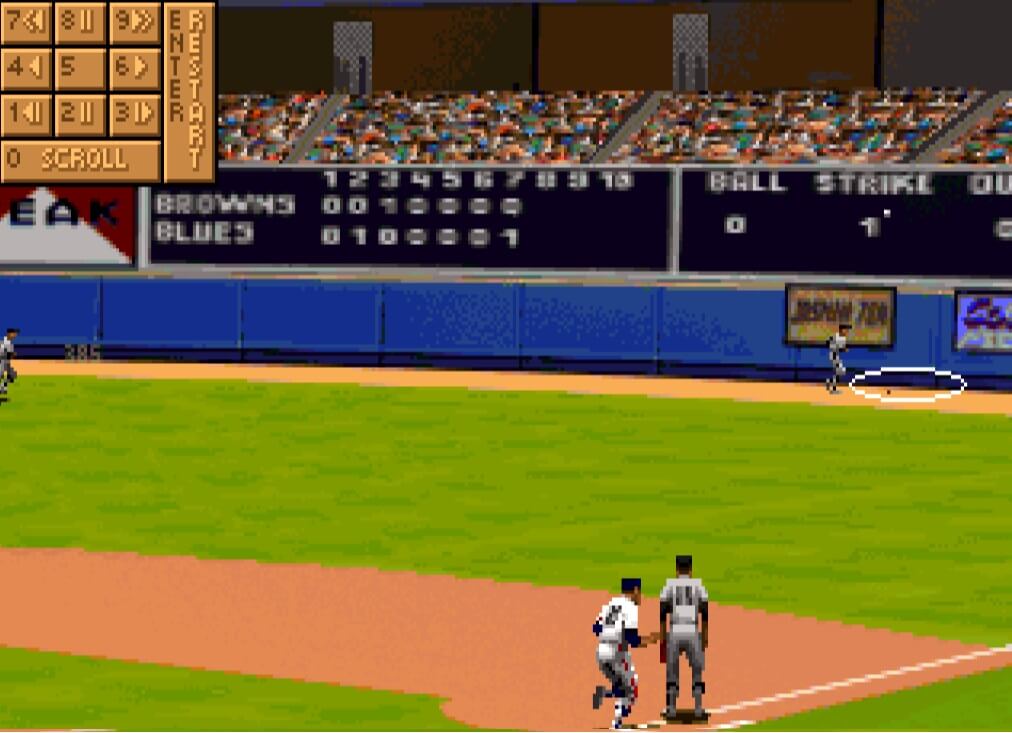
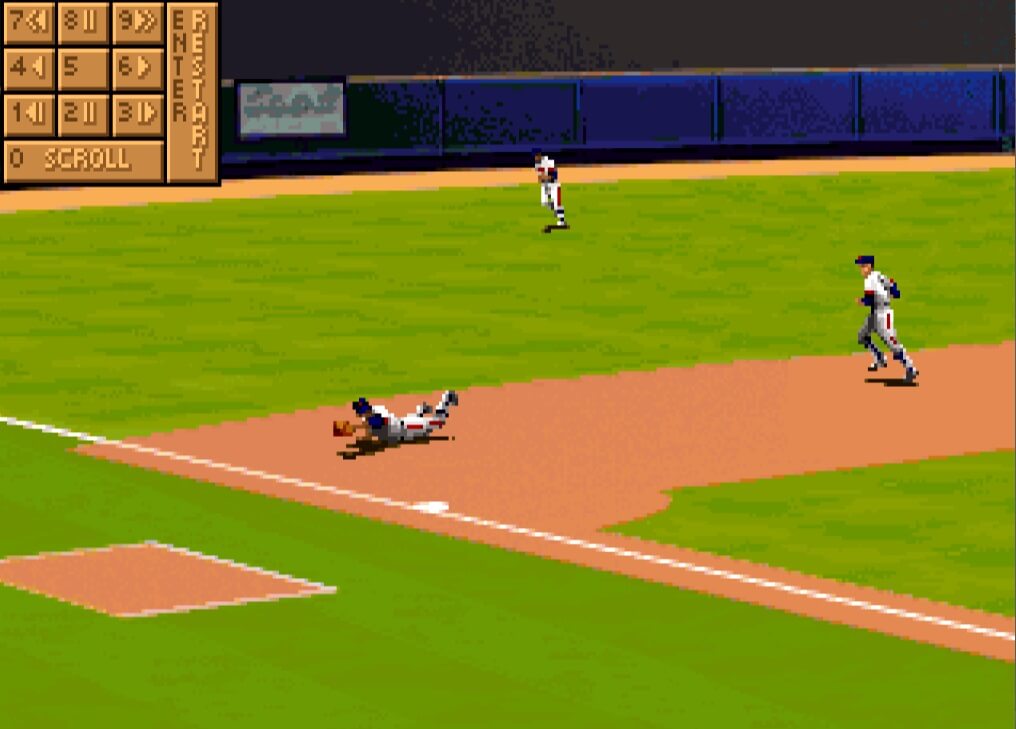
Articles in the Series
Additional Links
SABR Stay at Home – Don Daglow
Play ESPN Baseball Tonight in your browser -> https://archive.org/details/msdos_ESPN_Baseball_Tonight_1994
ESPN Baseball Tonight – Gindin, Jim. “Double Play: Turn Two With Reviews of Hardball IV and ESPN Baseball Tonight”. Computer Gaming World. April 1995. p132, 134, 136. http://www.cgwmuseum.org/galleries/issues/cgw_129.pdf
ESPN Baseball Tonight – Gindin, Jim. “Baseball: Diamonds Are A Fan’s Best Friend”. Computer Gaming World. May 1995. p62. http://www.cgwmuseum.org/galleries/issues/cgw_130.pdf
ESPN Baseball Tonight – Jones, George. “ESPN Baseball Tonight: Chris Berman Charisma, Tony La Russa Design”. Computer Gaming World. February 1995. p132, 134. http://www.cgwmuseum.org/galleries/issues/cgw_127.pdf
https://www.mobygames.com/game/dos/espn-baseball-tonight
https://www.youtube.com/watch?v=aWJOEk66K9o ESPN Baseball Tonight preview from IE (Interactive Entertainment, video by fmvgamer2010
The Sega Genesis manual (PDF) for ESPN Baseball Tonight ->
https://r.mprd.se/Sega%20CD/Manuals/ESPN%20Baseball%20Tonight%20(U).pdf
About the Author
I am a New Jersey native with a passion for baseball, statistics, computers and video games who enjoys spending quality time with his family.
“Hardball Architects – Volume 1 (American League)“, published in July 2020 and
“Hardball Architects – Volume 2 (National League)”, published in April 2022, examine the trades, free agent acquisitions, draft picks and other transactions for the 30 Major League Baseball franchises, divided into a 2-volume set. Both books are available in paperback and digital (Kindle) format at Amazon.com. All key moves are scrutinized for every team and Sabermetric principles are applied to the roster construction throughout the lifetime of the organization to encapsulate the hits and misses by front office executives. Team performances are analyzed based on transaction type with graphs depicting the WAR (Wins Above Replacement) in every decade. Individual results for each player-transaction is charted over the duration of their stint with the franchise. Every team chapter includes All-Time Rosters and Single-Season Leaders based on transaction type. The Team Trade Record chronicles the WAR and WS (Win Shares) accumulated by players acquired in comparison to those traded to opposing teams. The opening chapter is devoted to the Evolution of the General Manager and incorporates a discussion with former Dodgers GM Fred Claire (along with former Angels and Red Sox GM Mike Port and current Reds GM Nick Krall in Volume 2) on a variety of front office topics.
“Hardball Retroactive”, published in June 2018, is available in paperback and digital (Kindle) format at Amazon.com. Hardball Retroactive is a modest collection of selected articles that I have written for Seamheads.com along with my Baseball Analytics blog since 2010. Exclusive content includes the chapter on “Minors vs. Majors” which assesses every franchise’s minor league successes and failures in relation to their major league operations.
“Hardball Retrospective” is available in paperback and digital (Kindle) format at Amazon.com. Supplemental Statistics, Charts and Graphs along with a discussion forum are offered at TuataraSoftware.com. In Hardball Retrospective, I placed every ballplayer in the modern era (from 1901-present) on their original teams. Using a variety of advanced statistics and methods, I generated revised standings for each season based entirely on the performance of each team’s “original” players. I discuss every team’s “original” players and seasons at length along with organizational performance with respect to the Amateur Draft (or First-Year Player Draft), amateur free agent signings and other methods of player acquisition. Season standings, WAR and Win Shares totals for the “original” teams are compared against the real-time or “actual” team results to assess each franchise’s scouting, development and general management skills.
Don Daglow (Intellivision World Series Major League Baseball, Earl Weaver Baseball, Tony LaRussa Baseball) contributed the foreword for Hardball Retrospective. The foreword and preview of my book are accessible here.
“Hardball Retrospective – Addendum 2014 to 2016” supplements my research for Hardball Retrospective, providing retroactive standings based on Wins Above Replacement (WAR) and Win Shares (WS) for each “original” team over the past three seasons (2014-2016). Team totals from 2010 – 2013 are included for reference purposes. “Addendum” is available in paperback and digital (Kindle) format at Amazon.com.
I am a New Jersey native with a passion for baseball, statistics, computers and video games who enjoys spending quality time with his family. Co-chair of the SABR Games and Simulations Committee (https://sabrbaseballgaming.com) since August 2022.
Visit my Amazon author page to check out my books, promotional videos, and post a review if you're a Hardball Retro fan!
https://www.amazon.com/author/derekbain
My Books:
“Hardball Retro’s Compendium of Baseball Video Games and Electronic Handhelds”,published in September 2024 with co-author John Racanelli, is available in paperback and digital (Kindle) format at Amazon.com.
“Hardball Architects – Volume 1 (American League Teams)”,published in July 2020, is available in paperback and digital (Kindle) format at Amazon.com.
“Hardball Architects – Volume 2 (National League Teams)”,published in April 2022, is available in paperback and digital (Kindle) format at Amazon.com.
“Hardball Architects” examines the trades, free agent acquisitions, draft picks and other transactions for the 30 Major League Baseball franchises, divided into a 2-volume set (American League and National League). All key moves are scrutinized for every team and Sabermetric principles are applied to the roster construction throughout the lifetime of the organization to encapsulate the hits and misses by front office executives.
“Hardball Retroactive”,published in June 2018, is available in paperback and digital (Kindle) format at Amazon.com. A cross-section of essays that I penned for Seamheads.com along with my Baseball Analytics blog spanning nearly a decade touching on subjects including "Taking the Extra Base", "General Manager Scorecard", "Worst Trades", "BABIP By Location" and "Baseball Birthplaces and the Retro World Baseball Classic". Rediscover your favorite hardball arcade and simulations in "Play Retro Baseball Video Games In Your Browser" or take a deep dive into every franchise's minor league successes and failures in relation to their major league operations in "Minors vs. Majors".
“Hardball Retrospective” is available in paperback and digital (Kindle) format at Amazon.com.Supplemental Statistics, Charts and Graphs along with a discussion forum are offered at TuataraSoftware.com. In Hardball Retrospective, I placed every ballplayer in the modern era (from 1901-present) on their original teams. Using a variety of advanced statistics and methods, I generated revised standings for each season based entirely on the performance of each team’s “original” players. I discuss every team’s “original” players and seasons at length along with organizational performance with respect to the Amateur Draft (or First-Year Player Draft), amateur free agent signings and other methods of player acquisition. Season standings, WAR and Win Shares totals for the “original” teams are compared against the real-time or “actual” team results to assess each franchise’s scouting, development and general management skills.
Don Daglow (Intellivision World Series Major League Baseball, Earl Weaver Baseball, Tony LaRussa Baseball) contributed the foreword for Hardball Retrospective. The foreword and preview of my book are accessible here.
“Hardball Retrospective - Addendum 2014 to 2016”supplements my research for Hardball Retrospective, providing retroactive standings based on Wins Above Replacement (WAR) and Win Shares (WS) for each "original" team over the past three seasons (2014-2016). Team totals from 2010 - 2013 are included for reference purposes. “Addendum” is available in paperback and digital (Kindle) format at Amazon.com.
Contact me on BlueSky - @hardballretro.bsky.social
